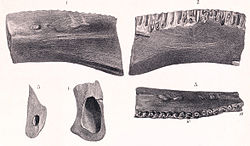Regnosaurus
|
Regnosaurus Temporal range: Early Cretaceous |
|
|---|---|
 |
|
| Holotype jaw fragment | |
| Scientific classification | |
| Kingdom: | Animalia |
| Phylum: | Chordata |
| Class: | Sauropsida |
| Superorder: | Dinosauria |
| Order: | Ornithischia |
| Suborder: | Thyreophora |
| Infraorder: | Stegosauria |
| Family: | Huayangosauridae |
| Genus: |
Regnosaurus Mantell, 1848 |
| Species | |
|
|
Regnosaurus (meaning "Sussex lizard") is a genus of herbivorous stegosaurian dinosaur that lived during the Early Cretaceous Period in what is now England.
The fossil remains, a portion of the right lower jaw, were found near Cuckfield in Sussex, and made part of the collection of the British Museum of Natural History. In 1839 Gideon Mantell reported having noticed the fossil during a visit. Mantell soon came to the conclusion that the specimen represented the, until then unknown, lower jaw of his Iguanodon, probably that of a juvenile. On 8 February 1841 he presented it as such to the Royal Society. This interpretation was immediately challenged by Richard Owen, who felt that any proof of a connection was lacking. In 1848, after several real jaws of Iguanodon had been discovered, Mantell changed his position, concluding it was a related but different genus or subgenus, coining the name Regnosaurus Northamptoni. The generic name is derived from the Regni or Regnenses, a British tribe inhabiting Sussex. The specific name honours Spencer Compton, 2nd Marquess of Northampton, the president of the Royal Society, who was about to resign. By present conventions, the type species is written as Regnosaurus northamptoni.
Regnosaurus is known only from the holotype BMNH 2422, a right mandibular (lower jaw) fragment, consisting of a third of the dentary and a part of the splenial. The specimen is six inches long and shows fifteen tooth sockets. Also some replacement teeth are visible. Other bone fragments have sometimes been referred to Regnosaurus, such as a fossil pubis recovered on the Isle of Wight, but as these are of other parts of the body and a reasonably complete skeleton is lacking, the identity cannot be proven. The same is true for some dermal spikes reported by William Blows.Regnosaurus was probably a rather small animal, about 4 metres (13 feet) long.
...
Wikipedia
